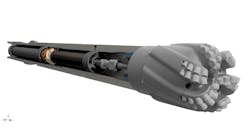New rotary steerable systems improve drilling efficiency
As the offshore drilling market recovers, downhole service providers are introducing and advancing rotary steerable systems (RSS) that enhance efficiency and deliver accurate wellbore placement and quality.
Enteq Upstream, the newest company to Offshore’s annual RSS directory, has introduced the SABER (Steer-At-Bit Enteq Rotary) tool for directional drilling. Shell has proven and tested an evolution of the concept, and the system is now ready for next-stage field trials.
SABER uses an internally directed pressure differential system to steer from the drill bit face, which is said to provide true ‘at-bit’ geosteering. The mechanically simple design, the company said, avoids the need for traditional pistons and pads susceptible to rapid wear and reliability issues, resulting in a smoother, more precise wellbore with easy to manage directional control.
Enteq is pitching the system as a reliable, simple, and cost-effective directional drilling alternative to current RSS options. The company licensed the designs and intellectual property from Shell in September 2019 following successful initial trials. Its technical team has since re-engineered the concept.
Baker Hughes has added the Lucida rotary steerable service to its directional drilling offerings.
According to the company, drilling performance is optimized through an integrated bottomhole assembly that features a customized drill bit, real-time dynamics sensors, and multi-chip module electronics. The near-bit dynamic sensors measure downhole weight-on-bit, torque, bending moment and direction, while the accelerometers in the primary electronics measure axial and lateral vibration as well as high-frequency torsional oscillations. The real-time bending moment and direction measurements are said to enhance directional control and can also be used for stringer detection. The multi-chip module electronics are said to increase reliability and operating range.
The new RSS enables drillers to hit their geological targets the first time, with no side tracks, the company claimed. Located near the bit, 16-sector gamma-ray sensors provide real-time formation data that enable quick decisions to geosteer or geo-stop.
Lucida is said to enhance wellbore quality through a combination of automated well path trajectory control and continuous proportional steering that automatically corrects wellbore course for any formation trends. The integration and automation in these systems, the company said, reduces wellbore tortuosity, providing a corresponding reduction in torque and drag, to drill better curve sections and longer and faster lateral sections. The automated well path trajectory control system is said to deliver precise control, even at very high penetration rates, with near-bit directional sensors that check azimuth and inclination every millisecond. The continuous proportional steering system addresses formation and drilling challenges by optimizing the drill bit and hydraulics program with precision-controlled pads that operate independently of bit pressure, flow rates, and drilling fluid properties.
According to the company, this system uses three precision-controlled pads to maintain a continuous proportional steering vector that drills a smooth, in-gauge hole. Steering control is not affected by drilling dynamics because the independent ribs are powered by internal hydraulic power on the decoupled slow rotating sleeve.
The new RSS is fully enabled for the company’s remote operations services.
Schlumberger’s PowerDrive Orbit G2 RSS is said to deliver higher abrasion resistance and dogleg severity (DLS) for tougher, longer runs. Its pad design increases abrasion resistance with metal-to-metal sealing to handle aggressive drilling fluids and severe downhole conditions for longer runs.
The system includes six-axis continuous hold inclination and azimuth measurements to enable precise well positioning. This feature, along with closed-loop automation, the company said, provides smoother tangents with minimized tortuosity. Near-bit extended-range gamma ray measurements transmit additional well positioning data for improved real-time decision making.
The PowerDrive Orbit G2 RSS recently drilled the horizontal section of a complex well offshore Indonesia in one run.
Interbedded and fractured carbonates posed a challenge for drilling the horizontal section of wells in the East Java basin. To drill the horizontal, the operator needed to overcome the constant microdoglegs observed in offset wells that resulted in unstable DLS, severe shock and vibration, and stick/slip conditions, compromising directional control and ROP. Conventional RSS tools had difficulties precisely and consistently landing offset wells inside the reservoir with sufficient DLS, the company said.
In concert with the MicroScope HD resistivity and high-definition imaging-while drilling service to better navigate the well trajectory, the RSS was used to deliver higher DLS and wear resistance in harsh downhole conditions for longer runs with greater trajectory control.
According to the company, the system increased the maximum DLS by 50% and the average DLS by 80% while maintaining a constant steering ratio and reducing wellbore tortuosity and microdoglegs.
Earlier this year, Weatherford deployed its Magnus RSS in the North Sea for the first time. A major operator in the UK decided to replace technology from the incumbent to drill re-entries in an existing field and boost production. According to the company, the Magnus system not only surpassed the technical limit set by the customer, but also drilled the first three re-entry wells an average of 33% faster than planned. This success led to contracts with two more customers in the region.
Key features of the push-the-bit tool include fully independent pad control, a fully rotating bias unit with minimal bottomhole assembly (BHA) stabilization, real-time BHA diagnostics, and autopilot functionality. The system comprises several modular components to facilitate quick and easy maintenance, even in remote locations.
The 2021 Rotary Steerable Systems Directory provides a detailed listing of the technology available on the market.
About the Author
Jessica Stump
Editor
Jessica Stump is editor of Offshore Magazine. She uploads and writes news to the website, assembles surveys and electronic newsletters, and writes and edits articles for the magazine. She was the summer editorial intern at Offshore in 2009 and 2010 before joining full time in April 2011. She has a journalism degree from Texas Tech University.

